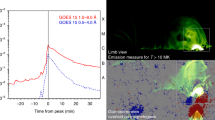Abstract
The electrodynamic flare model is based on numerical 3D simulations with the real magnetic field of an active region. An energy of ∼1032 erg necessary for a solar flare is shown to accumulate in the magnetic field of a coronal current sheet. The thermal X-ray source in the corona results from plasma heating in the current sheet upon reconnection. The hard X-ray sources are located on the solar surface at the loop foot-points. They are produced by the precipitation of electron beams accelerated in field-aligned currents. Solar cosmic rays appear upon acceleration in the electric field along a singular magnetic X-type line. The generation mechanism of the delayed cosmic-ray component is also discussed.
Similar content being viewed by others
References
L. A. Artsimovich, E. I. Dobrokhotov, S. Yu. Luk’yanov, et al., “Gas Discharge Neutron Emission,” At. Energ., No. 3, 84–87 (1956).
Yu. V. Balabin, E. V. Vashenyuk, O. V. Mingalev, et al., “The Spectrum of Solar Cosmic Rays: Data of Observations and Numerical Simulation,” Astron. Rep. 49, 940–949 (2005).
R. P. Lin, S. Krucker, G. J. Harford, et al., “RHESSI Observation of Patcle Acceleration and Energy Release in Solar Flare,” Astrophys. J. 595, L69–L76 (2003).
S. Yu. Luk’yanov and I. M. Podgorny, “Hard X-rays Accompanying Gas Discharge,” At. Energ., No. 3, 93–103 (1956).
A. I. Podgorny and I. M. Podgorny, “Solar Flare Model: A Comparison with the Observation of High-Energy Processes,” Astron. Rep. 50, 842–850 (2006).
A. I. Podgorny and I. M. Podgorny, “Solar Flare Model Including the Formation and Destruction of the Current Sheet in the Corona,” Solar Phys. 139, 125–145 (1992).
I. M. Podgorny and A. I. Podgorny, “MHD Modeling of the Current Sheet Formation above a Bipolar Region,” Astron. Rep. 47, 696–702 (2003).
A. I. Podgorny, “The Magnetohydrodynamical Instability of a Current Sheet Created by Plasma Flow,” Plasma Phys. Contr. Fusion 31, 1271–1279 (1989).
I. M. Podgorny, N. G. Koval’skii, and V. E. Pal’chikov, “Electrons that Cause Hard X-rays of Impulsive Discharges,” Dokl. Akad. Nauk SSSR 123, 825–828 (1958).
E. V. Vashenyuk and L. I. Miroshnichenko, “Relativistic Solar Protons in the Ground Level Event of February 23, 1956: New Study,” Adv. Space Res. (2007) (in press).
E. V. Vashenyuk, Yu. V. Balabin, J. Perez-Peraza, et al., “Some Features of the Solar Cycles 21–23,” Adv. Res 36(3), 411–417 (2006).
Author information
Authors and Affiliations
Additional information
Original Russian Text © I.M. Podgorny, E.V. Vashenyuk, A.I. Podgorny, 2008, published in Solnechno-Zemnaya Fizika, 2008, Vol. 12, No. 1, pp. 62–66.
Rights and permissions
About this article
Cite this article
Podgorny, I.M., Vashenyuk, E.V. & Podgorny, A.I. Solar flare model: Comparison of the results of numerical simulations and observations. Geomagn. Aeron. 49, 1115–1119 (2009). https://doi.org/10.1134/S0016793209080143
Received:
Published:
Issue Date:
DOI: https://doi.org/10.1134/S0016793209080143




